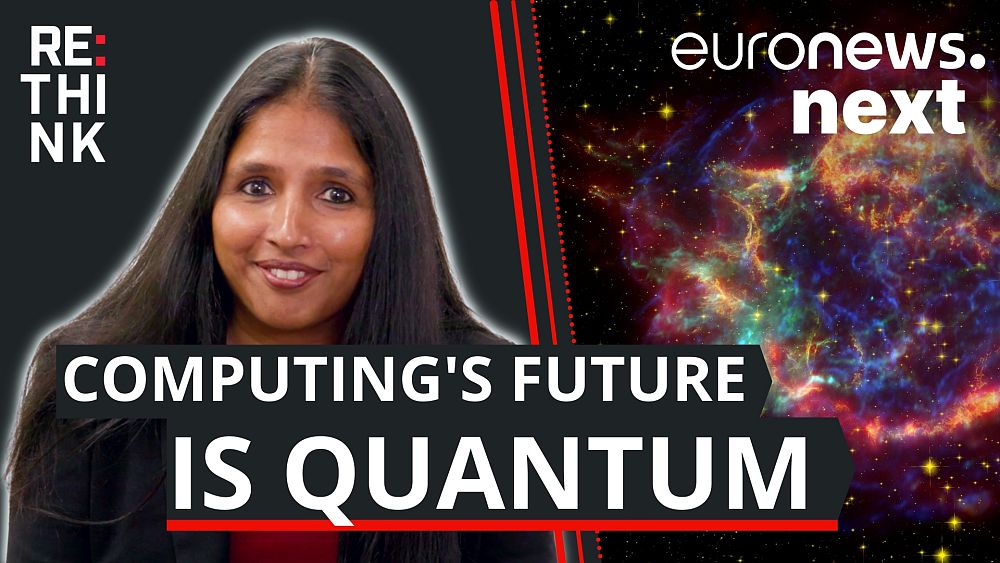
The potential of quantum computing has been hailed as revolutionary, able to change the way everything in our world works by finding solutions exponentially faster than today’s most powerful supercomputers.
But as executives calculate the potential revenues that quantum could generate and journalists scramble to find simple ways to explain the complex processes behind it, quantum physicists have grown increasingly frustrated by a lack of understanding of their field.
“Quantum computing is actually very different from our regular computing,” quantum physicist Shohini Ghose, a professor at Wilfrid Laurier University in Canada, told Euronews Next.
“It’s not just that this is a more powerful version of what we have today. It’s actually an entirely different framework for computing itself”.
That framework is hard to explain with simple analogies and familiar benchmarks.
A quantum computer is not X times more powerful than a normal computer. It’s not the Real Madrid to your child’s football team. A quantum computer is playing an entirely different game.
“It’s not the case that a quantum computer is better at every task and will somehow speed up everything we do,” Ghose said.
“There are very specific tasks that a quantum computer can actually do in ways that are better”.
Understanding computing’s new framework
Normal computers – from the ones we use at work to the record-breaking Frontier supercomputer – work by converting information to binary digits (ones and zeroes), known as bits. They process long strings of these bits called code, and use simple mathematics to tell that code what to do.
A quantum computing framework is based on a different basic unit of information, called a quantum bit, which operates on a principle called superposition.
“Imagine a situation where our bit is not quite a zero and not quite a one, but it has some probability of being a zero and some probability of being a one,” Ghose said.
“That’s what we call a superposition, and that is what a quantum bit, or qubit, is described as”.
That may sound less precise, but Ghose says it vastly expands the types of calculations a quantum computer can solve and in many cases, increases the speed at which it can reach a solution.
“It’s almost like going from two points – 0 and 1 – in a landscape, to being able to flow anywhere in the landscape because any combination of zero and one is possible,” she said.
Game-changing potential
So, what can quantum computers do better than normal computers?
“If you’re just writing emails, you’re not going to see a huge speed up somehow that will make your emails faster or better,” Ghose said.
“But what might happen is that at the back end, a quantum encryption system might be able to improve the security and the privacy of your communication”.
Shohini Ghose
Quantum physicist
Quantum cryptography is a major area of research that draws on quantum mechanics to improve the security of online communications. Ghose says that back-end quantum encryption could eventually feature on all of our devices.
“If this is done in a way that is really error-free and engineered perfectly, it’s completely unhackable,” she said. “Meaning to break this encryption, you would have to break the laws of physics”.
Other applications depend on the ability to build large-scale quantum computers. Those could range from developing better pharmaceuticals to building better solar cells and even clothing.
But to really expand the applications of quantum computing, Ghose says experts from different fields need to get involved in the research.
“You don’t have to be a physicist to be part of this new quantum computing revolution,” she said.
“In fact, the more diverse groups of people can be involved, the richer the field will be and the more surprising the results”.
A long road ahead for quantum
There are still a lot of questions that need to be answered before quantum computing can enter the mainstream. First and foremost is whether large-scale quantum computers can even be built.
“It’s not quite clear whether we can even really scale them up, because nobody has been able to show decisively that as we build larger and larger quantum computers, we’re going to be able to do it in a way that’s sustainable and scalable,” Ghose said.
Qubits need to be kept at near absolute zero temperatures to function, making heat management a major hurdle developers need to address.
Cost is also an issue – most estimates put the cost of a single qubit at around €10,000, making a useful quantum computer prohibitively expensive for all but a few industries.
But Ghose says the single biggest challenge and unknown of quantum computing is dealing with quantum errors.
“Part of what makes a quantum computer powerful is this particular phenomenon called entanglement, where all the different quantum bits talk to each other and get connected in such a way that they sort of start acting as one,” she said.
Shohini Ghose
Quantum physicist
“But if those qubits, instead of talking to each other, talk to something outside their computing space, like some random particle, they can also get entangled with those particles”.
In order to control the qubits and keep them from interacting with random particles, Ghose says they need to be kept “colder than outer space”.
The only way to do that currently is by building massive computers “the size of an entire room,” which can fit all the hardware and electronics and cooling systems.
“We’ll have to do a lot of error correction because they’re very, very fragile and even the slightest bit of error or noise completely destroys the calculation,” Ghose said.
“That’s what we have to think about as we move forward, is it really worth it? And if so, how do we do it in a way that’s responsible and sustainable? I don’t know the answer”.
For more on this story, watch the video in the media player above.
Video editor • Ivan Sougy
Additional sources • Motion Designer: Matthew Ashe, Executive producer: Thomas Duthois

